seats Seat Altea Freetrack 2012 Owner's Manual
[x] Cancel search | Manufacturer: SEAT, Model Year: 2012, Model line: Altea Freetrack, Model: Seat Altea Freetrack 2012Pages: 297, PDF Size: 4.31 MB
Page 5 of 297
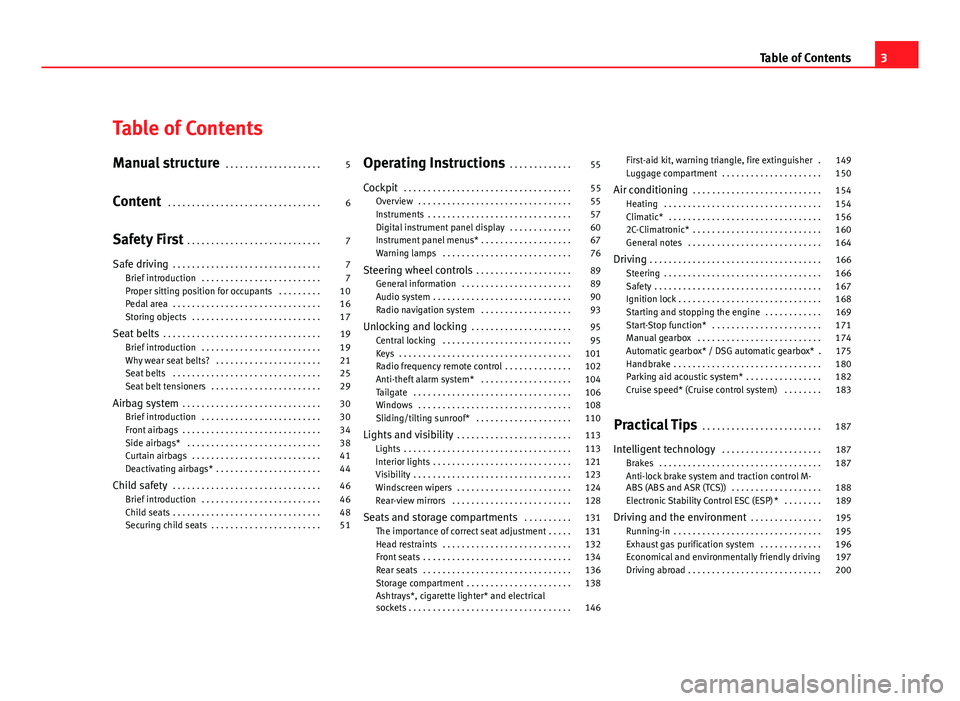
Table of Contents
Manual structure . . . . . . . . . . . . . . . . . . . . 5
Content . . . . . . . . . . . . . . . . . . . . . . . . . . . . . . . . 6
Safety First . . . . . . . . . . . . . . . . . . . . . . . . . . . . 7
Safe driving . . . . . . . . . . . . . . . . . . . . . . . . . . . . . . . 7
Brief introduction . . . . . . . . . . . . . . . . . . . . . . . . . 7
Proper sitting position for occupants . . . . . . . . . 10
Pedal area . . . . . . . . . . . . . . . . . . . . . . . . . . . . . . . 16
Storing objects . . . . . . . . . . . . . . . . . . . . . . . . . . . 17
Seat belts . . . . . . . . . . . . . . . . . . . . . . . . . . . . . . . . . 19
Brief introduction . . . . . . . . . . . . . . . . . . . . . . . . . 19
Why wear seat belts? . . . . . . . . . . . . . . . . . . . . . . 21
Seat belts . . . . . . . . . . . . . . . . . . . . . . . . . . . . . . . 25
Seat belt tensioners . . . . . . . . . . . . . . . . . . . . . . . 29
Airbag system . . . . . . . . . . . . . . . . . . . . . . . . . . . . . 30
Brief introduction . . . . . . . . . . . . . . . . . . . . . . . . . 30
Front airbags . . . . . . . . . . . . . . . . . . . . . . . . . . . . . 34
Side airbags* . . . . . . . . . . . . . . . . . . . . . . . . . . . . 38
Curtain airbags . . . . . . . . . . . . . . . . . . . . . . . . . . . 41
Deactivating airbags* . . . . . . . . . . . . . . . . . . . . . . 44
Child safety . . . . . . . . . . . . . . . . . . . . . . . . . . . . . . . 46
Brief introduction . . . . . . . . . . . . . . . . . . . . . . . . . 46
Child seats . . . . . . . . . . . . . . . . . . . . . . . . . . . . . . . 48
Securing child seats . . . . . . . . . . . . . . . . . . . . . . . 51 Operating Instructions
. . . . . . . . . . . . . 55
Cockpit . . . . . . . . . . . . . . . . . . . . . . . . . . . . . . . . . . . 55
Overview . . . . . . . . . . . . . . . . . . . . . . . . . . . . . . . . 55
Instruments . . . . . . . . . . . . . . . . . . . . . . . . . . . . . . 57
Digital instrument panel display . . . . . . . . . . . . . 60
Instrument panel menus* . . . . . . . . . . . . . . . . . . . 67
Warning lamps . . . . . . . . . . . . . . . . . . . . . . . . . . . 76
Steering wheel controls . . . . . . . . . . . . . . . . . . . . 89
General information . . . . . . . . . . . . . . . . . . . . . . . 89
Audio system . . . . . . . . . . . . . . . . . . . . . . . . . . . . . 90
Radio navigation system . . . . . . . . . . . . . . . . . . . 93
Unlocking and locking . . . . . . . . . . . . . . . . . . . . . 95
Central locking . . . . . . . . . . . . . . . . . . . . . . . . . . . 95
Keys . . . . . . . . . . . . . . . . . . . . . . . . . . . . . . . . . . . . 101
Radio frequency remote control . . . . . . . . . . . . . . 102
Anti-theft alarm system* . . . . . . . . . . . . . . . . . . . 104
Tailgate . . . . . . . . . . . . . . . . . . . . . . . . . . . . . . . . . 106
Windows . . . . . . . . . . . . . . . . . . . . . . . . . . . . . . . . 108
Sliding/tilting sunroof* . . . . . . . . . . . . . . . . . . . . 110
Lights and visibility . . . . . . . . . . . . . . . . . . . . . . . . 113
Lights . . . . . . . . . . . . . . . . . . . . . . . . . . . . . . . . . . . 113
Interior lights . . . . . . . . . . . . . . . . . . . . . . . . . . . . . 121
Visibility . . . . . . . . . . . . . . . . . . . . . . . . . . . . . . . . . 123
Windscreen wipers . . . . . . . . . . . . . . . . . . . . . . . . 124
Rear-view mirrors . . . . . . . . . . . . . . . . . . . . . . . . . 128
Seats and storage compartments . . . . . . . . . . 131
The importance of correct seat adjustment . . . . . 131
Head restraints . . . . . . . . . . . . . . . . . . . . . . . . . . . 132
Front seats . . . . . . . . . . . . . . . . . . . . . . . . . . . . . . . 134
Rear seats . . . . . . . . . . . . . . . . . . . . . . . . . . . . . . . 136
Storage compartment . . . . . . . . . . . . . . . . . . . . . . 138
Ashtrays*, cigarette lighter* and electrical
sockets . . . . . . . . . . . . . . . . . . . . . . . . . . . . . . . . . . 146 First-aid kit, warning triangle, fire extinguisher . 149
Luggage compartment . . . . . . . . . . . . . . . . . . . . . 150
Air conditioning . . . . . . . . . . . . . . . . . . . . . . . . . . . 154
Heating . . . . . . . . . . . . . . . . . . . . . . . . . . . . . . . . . 154
Climatic* . . . . . . . . . . . . . . . . . . . . . . . . . . . . . . . . 156
2C-Climatronic* . . . . . . . . . . . . . . . . . . . . . . . . . . . 160
General notes . . . . . . . . . . . . . . . . . . . . . . . . . . . . 164
Driving . . . . . . . . . . . . . . . . . . . . . . . . . . . . . . . . . . . . 166
Steering . . . . . . . . . . . . . . . . . . . . . . . . . . . . . . . . . 166
Safety . . . . . . . . . . . . . . . . . . . . . . . . . . . . . . . . . . . 167
Ignition lock . . . . . . . . . . . . . . . . . . . . . . . . . . . . . . 168
Starting and stopping the engine . . . . . . . . . . . . 169
Start-Stop function* . . . . . . . . . . . . . . . . . . . . . . . 171
Manual gearbox . . . . . . . . . . . . . . . . . . . . . . . . . . 174
Automatic gearbox* / DSG automatic gearbox* . 175
Handbrake . . . . . . . . . . . . . . . . . . . . . . . . . . . . . . . 180
Parking aid acoustic system* . . . . . . . . . . . . . . . . 182
Cruise speed* (Cruise control system) . . . . . . . . 183
Practical Tips . . . . . . . . . . . . . . . . . . . . . . . . . 187
Intelligent technology . . . . . . . . . . . . . . . . . . . . . 187
Brakes . . . . . . . . . . . . . . . . . . . . . . . . . . . . . . . . . . 187
Anti-lock brake system and traction control M-
ABS (ABS and ASR (TCS)) . . . . . . . . . . . . . . . . . . . 188
Electronic Stability Control ESC (ESP) * . . . . . . . . 189
Driving and the environment . . . . . . . . . . . . . . . 195
Running-in . . . . . . . . . . . . . . . . . . . . . . . . . . . . . . . 195
Exhaust gas purification system . . . . . . . . . . . . . 196
Economical and environmentally friendly driving 197
Driving abroad . . . . . . . . . . . . . . . . . . . . . . . . . . . . 200
3
Table of Contents
Page 8 of 297
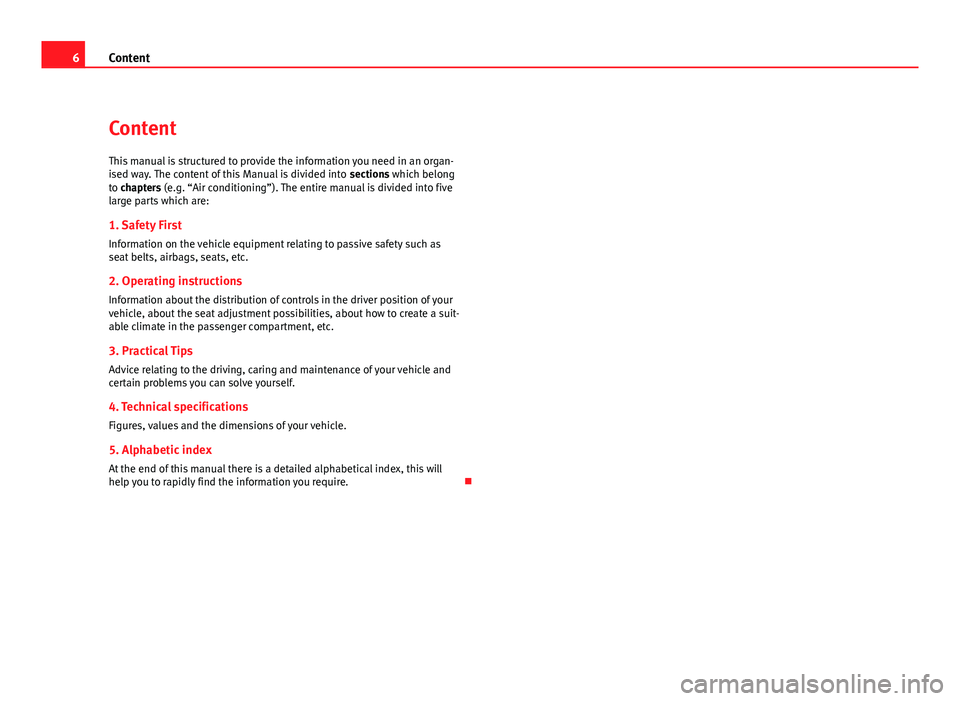
6Content
Content
This manual is structured to provide the information you need in an organ-
ised way. The content of this Manual is divided into sections which belong
to chapters (e.g. “Air conditioning”). The entire manual is divided into five
large parts which are:
1. Safety First Information on the vehicle equipment relating to passive safety such as
seat belts, airbags, seats, etc.
2. Operating instructions
Information about the distribution of controls in the driver position of your
vehicle, about the seat adjustment possibilities, about how to create a suit-
able climate in the passenger compartment, etc.
3. Practical Tips
Advice relating to the driving, caring and maintenance of your vehicle and
certain problems you can solve yourself.
4. Technical specifications
Figures, values and the dimensions of your vehicle.
5. Alphabetic index
At the end of this manual there is a detailed alphabetical index, this will
help you to rapidly find the information you require.
Page 9 of 297
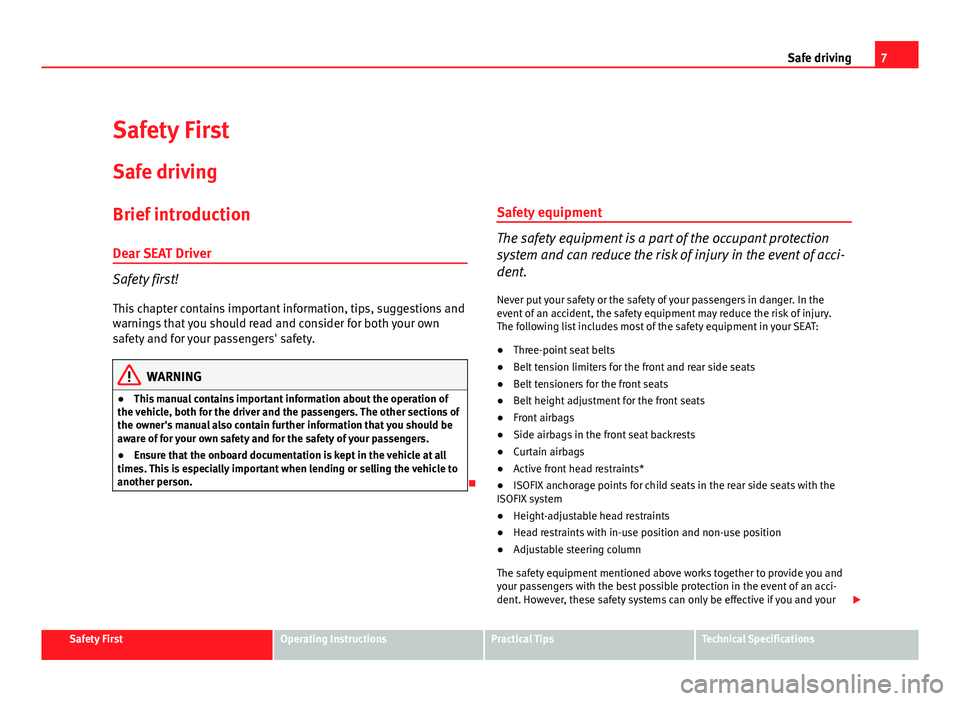
7
Safe driving
Safety First
Safe driving
Brief introduction
Dear SEAT Driver
Safety first! This chapter contains important information, tips, suggestions and
warnings that you should read and consider for both your own
safety and for your passengers' safety.
WARNING
● This manual contains important information about the operation of
the vehicle, both for the driver and the passengers. The other sections of
the owner's manual also contain further information that you should be
aware of for your own safety and for the safety of your passengers.
● Ensure that the onboard documentation is kept in the vehicle at all
times. This is especially important when lending or selling the vehicle to
another person.
Safety equipment
The safety equipment is a part of the occupant protection
system and can reduce the risk of injury in the event of acci-
dent.
Never put your safety or the safety of your passengers in danger. In the
event of an accident, the safety equipment may reduce the risk of injury.
The following list includes most of the safety equipment in your SEAT:
● Three-point seat belts
● Belt tension limiters for the front and rear side seats
● Belt tensioners for the front seats
● Belt height adjustment for the front seats
● Front airbags
● Side airbags in the front seat backrests
● Curtain airbags
● Active front head restraints*
● ISOFIX anchorage points for child seats in the rear side seats with the
ISOFIX system
● Height-adjustable head restraints
● Head restraints with in-use position and non-use position
● Adjustable steering column
The safety equipment mentioned above works together to provide you and
your passengers with the best possible protection in the event of an acci-
dent. However, these safety systems can only be effective if you and your
Safety FirstOperating InstructionsPractical TipsTechnical Specifications
Page 10 of 297

8Safe driving
passengers are sitting in a correct position and use this equipment proper-
ly.
Therefore, information is provided about why this equipment is so impor-
tant, how it protects you, what you have to consider when using it and how
you and your passengers can achieve the greatest possible benefit from the
safety equipment fitted. This manual includes important warnings that you
and your passengers should note in order to reduce the risk of injury.
Safety is everyone's business!
Before setting off
The driver is responsible for the safety of the passengers
and the safe operation of the vehicle.
For your own safety and the safety of your passengers, always note
the following points before every trip:
– Make sure that the vehicle's lights and turn signals are working
properly.
– Check tyre pressure.
– Ensure that all windows provide a clear and good view of the
surroundings.
– Make sure all luggage is secured ⇒ page 17.
– Make sure that no objects can interfere with the pedals.
– Adjust front seat, head restraint and mirrors properly according
to your size. –
Ensure that the passengers in the rear seats always have the
head restraints in the in-use position ⇒ page 14
– Instruct passengers to adjust the head restraints according to
their height.
– Protect children with appropriate child seats and properly ap-
plied seat belts ⇒ page 46.
– Assume the correct sitting position. Instruct your passengers al-
so to assume a proper sitting position. ⇒ page 10.
– Fasten your seat belt securely. Instruct your passengers also to
fasten their seat belts properly. ⇒ page 19.
What affects driving safety?
Driving safety is largely determined by your driving style
and the personal behaviour of all occupants. As a driver, you are responsible for yourself and your passengers.
When your concentration or driving safety is affected by any cir-
cumstance, you endanger yourself as well as others on the road
⇒
, for this reason:
– Always pay attention to traffic and do not get distracted by pas-
sengers or telephone calls.
– Never drive when your driving ability is impaired (e.g. by medi-
cation, alcohol, drugs).
– Observe traffic laws and speed limits.
Page 14 of 297

12Safe driving
WARNING
● An incorrect sitting position of the front passenger can lead to severe
injuries.
● Adjust the front passenger seat so that there is at least 25 cm be-
tween your chest and the dash panel. If you are sitting closer than 25 cm,
the airbag system cannot protect you properly.
● If your physical constitution prevents you from maintaining the mini-
mum distance of 25 cm, contact a specialised workshop. The workshop
will help you decide if special specific modifications are necessary.
● Always keep your feet in the footwell when the vehicle is moving;
never rest them on the dash panel, out the window or on the seat. An in-
correct sitting position exposes you to an increased risk of injury in case
of a sudden braking or an accident. If the airbag is triggered, you could
sustain severe injuries due to an incorrect sitting position.
● To reduce the risk of injury to the front passenger in events such sud-
den braking manoeuvres or an accident, never travel with the backrest
tilted far back! The airbag system and seat belts can only provide optimal
protection when the backrest is in an upright position and the front pas-
senger is wearing his or her seat belt properly. The further the backrests
are tilted to the rear, the greater the risk of injury due to incorrect posi-
tioning of the belt web or to the incorrect sitting position!
● Adjust the head restraint properly in order to achieve maximum pro-
tection.
Correct sitting position for passengers in the rear seats
Passengers in the rear seats must sit up straight, keep their
feet on the footwells, have the head restraints positioned for
use and wear their seat belts properly.
To reduce the risk of injury in the event of a sudden braking ma-
noeuvre or an accident, passengers on the rear bench seat must
consider the following:
–
Adjust the head restraint to the correct position ⇒ page 14.
– Keep both feet in the footwell in front of the rear seat.
– Fasten your seat belt securely ⇒ page 19.
– Use an appropriate child restraint system when you take chil-
dren in the vehicle ⇒ page 46.
WARNING
● If the passengers on the rear seat are not sitting properly, they could
sustain severe injuries.
● Adjust the head restraint properly in order to achieve maximum pro-
tection.
● Seat belts can only provide optimal protection when backrests are in
an upright position and the passengers are wearing their seat belts prop-
erly. If passengers on the rear seat are not sitting in an upright position,
the risk of injury due to incorrect positioning of the seat belt increases.
Page 15 of 297

13
Safe driving
Correct adjustment of front seat head restraints
Properly adjusted head restraints are an important part of
passenger protection and can reduce the risk of injuries in
most accident situations.
Fig. 3 Properly adjusted
head restraint viewed
from the front
Fig. 4 Properly adjusted
head restraint viewed
from the side Adjust the head restraint properly in order to achieve maximum
protection.
–
Adjust the head restraint so that its upper edge is at the same
level as the top of your head or as close as possible to the same
level as the top of your head and, at the very least, at eye level
⇒ fig. 3 and ⇒ fig. 4.
Adjusting the head restraints ⇒ page 131.
WARNING
● Travelling with the head restraints removed or improperly adjusted
increases the risk of severe injuries.
● Incorrectly adjusted head restraints could result in death in the event
of a collision or accident.
● Incorrectly adjusted head restraints also increase the risk of injury
during sudden or unexpected driving or braking manoeuvres.
● The head restraints must always be adjusted according to the pas-
senger's height.
Active head restraints*
Vehicle occupants are pressed into their seats during a rear end collision.
The resulting body pressure on the backrest activates the active head re-
straint* on the front seat, which moves rapidly forwards and upwards at the
same time. This movement reduces the distance between the occupant's
head and the head restraint, thus reducing the risk of head injuries such as
brain trauma.
Safety FirstOperating InstructionsPractical TipsTechnical Specifications
Page 17 of 297
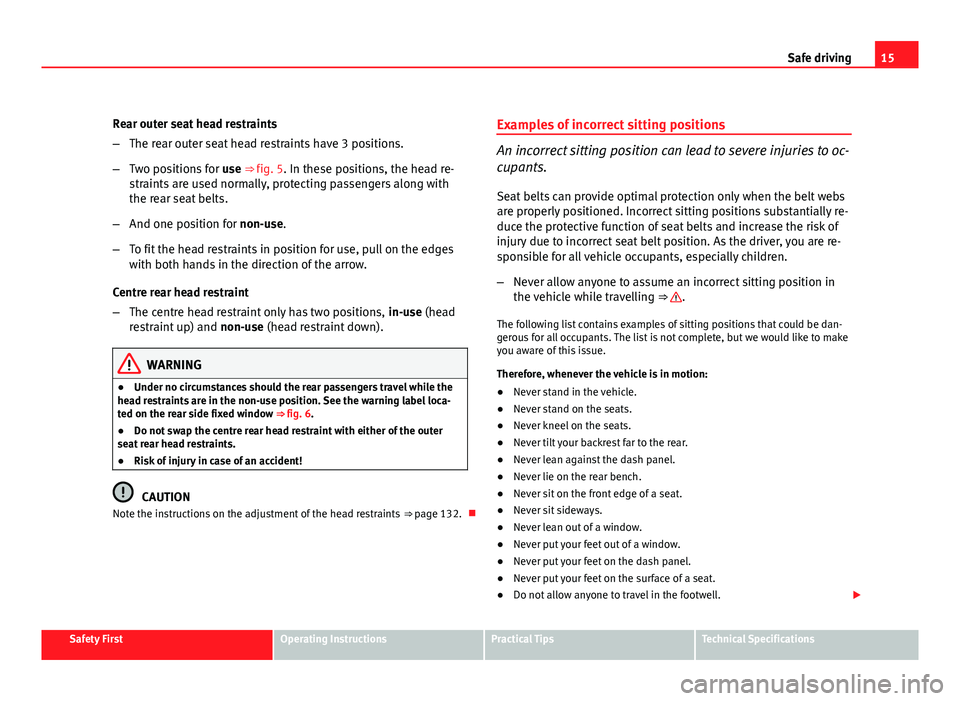
15
Safe driving
Rear outer seat head restraints
– The rear outer seat head restraints have 3 positions.
– Two positions for use ⇒ fig. 5. In these positions, the head re-
straints are used normally, protecting passengers along with
the rear seat belts.
– And one position for non-use.
– To fit the head restraints in position for use, pull on the edges
with both hands in the direction of the arrow.
Centre rear head restraint
– The centre head restraint only has two positions, in-use (head
restraint up) and non-use (head restraint down).
WARNING
● Under no circumstances should the rear passengers travel while the
head restraints are in the non-use position. See the warning label loca-
ted on the rear side fixed window ⇒ fig. 6.
● Do not swap the centre rear head restraint with either of the outer
seat rear head restraints.
● Risk of injury in case of an accident!
CAUTION
Note the instructions on the adjustment of the head restraints ⇒ page 132. Examples of incorrect sitting positions
An incorrect sitting position can lead to severe injuries to oc-
cupants.
Seat belts can provide optimal protection only when the belt webs
are properly positioned. Incorrect sitting positions substantially re-
duce the protective function of seat belts and increase the risk of
injury due to incorrect seat belt position. As the driver, you are re-
sponsible for all vehicle occupants, especially children.
– Never allow anyone to assume an incorrect sitting position in
the vehicle while travelling ⇒
.
The following list contains examples of sitting positions that could be dan-
gerous for all occupants. The list is not complete, but we would like to make
you aware of this issue.
Therefore, whenever the vehicle is in motion:
● Never stand in the vehicle.
● Never stand on the seats.
● Never kneel on the seats.
● Never tilt your backrest far to the rear.
● Never lean against the dash panel.
● Never lie on the rear bench.
● Never sit on the front edge of a seat.
● Never sit sideways.
● Never lean out of a window.
● Never put your feet out of a window.
● Never put your feet on the dash panel.
● Never put your feet on the surface of a seat.
● Do not allow anyone to travel in the footwell.
Safety FirstOperating InstructionsPractical TipsTechnical Specifications
Page 21 of 297
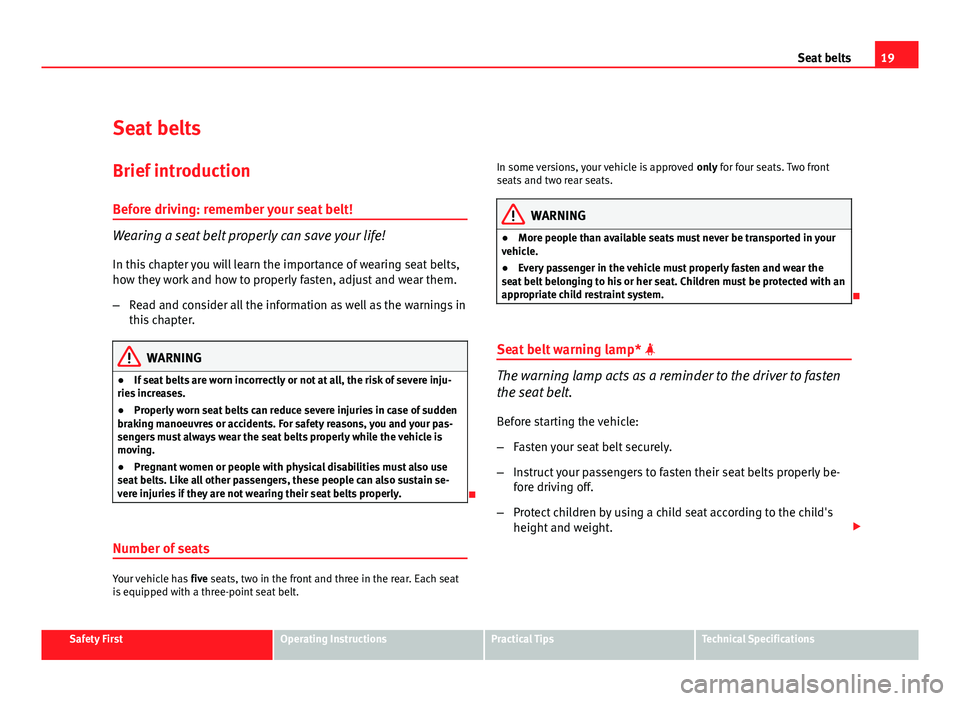
19
Seat belts
Seat belts
Brief introduction Before driving: remember your seat belt!
Wearing a seat belt properly can save your life!
In this chapter you will learn the importance of wearing seat belts,
how they work and how to properly fasten, adjust and wear them.
– Read and consider all the information as well as the warnings in
this chapter.
WARNING
● If seat belts are worn incorrectly or not at all, the risk of severe inju-
ries increases.
● Properly worn seat belts can reduce severe injuries in case of sudden
braking manoeuvres or accidents. For safety reasons, you and your pas-
sengers must always wear the seat belts properly while the vehicle is
moving.
● Pregnant women or people with physical disabilities must also use
seat belts. Like all other passengers, these people can also sustain se-
vere injuries if they are not wearing their seat belts properly.
Number of seats
Your vehicle has five seats, two in the front and three in the rear. Each seat
is equipped with a three-point seat belt. In some versions, your vehicle is approved
only for four seats. Two front
seats and two rear seats.
WARNING
● More people than available seats must never be transported in your
vehicle.
● Every passenger in the vehicle must properly fasten and wear the
seat belt belonging to his or her seat. Children must be protected with an
appropriate child restraint system.
Seat belt warning lamp*
The warning lamp acts as a reminder to the driver to fasten
the seat belt.
Before starting the vehicle:
– Fasten your seat belt securely.
– Instruct your passengers to fasten their seat belts properly be-
fore driving off.
– Protect children by using a child seat according to the child's
height and weight.
Safety FirstOperating InstructionsPractical TipsTechnical Specifications
Page 27 of 297
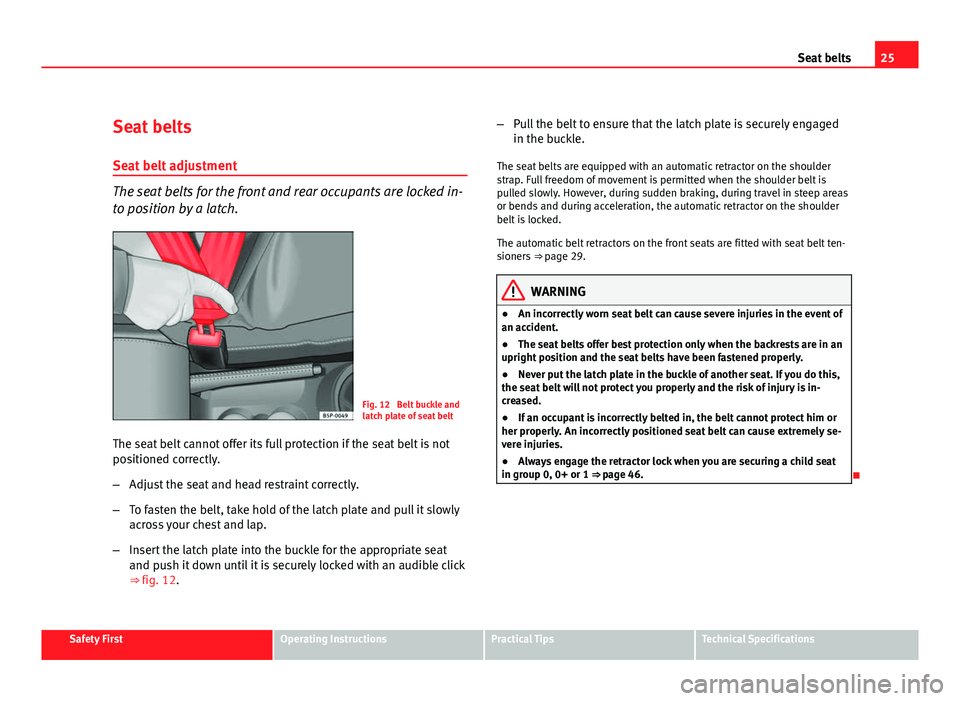
25
Seat belts
Seat belts
Seat belt adjustment
The seat belts for the front and rear occupants are locked in-
to position by a latch.
Fig. 12 Belt buckle and
latch plate of seat belt
The seat belt cannot offer its full protection if the seat belt is not
positioned correctly.
– Adjust the seat and head restraint correctly.
– To fasten the belt, take hold of the latch plate and pull it slowly
across your chest and lap.
– Insert the latch plate into the buckle for the appropriate seat
and push it down until it is securely locked with an audible click
⇒ fig. 12. –
Pull the belt to ensure that the latch plate is securely engaged
in the buckle.
The seat belts are equipped with an automatic retractor on the shoulder
strap. Full freedom of movement is permitted when the shoulder belt is
pulled slowly. However, during sudden braking, during travel in steep areas
or bends and during acceleration, the automatic retractor on the shoulder
belt is locked.
The automatic belt retractors on the front seats are fitted with seat belt ten-
sioners ⇒ page 29.
WARNING
● An incorrectly worn seat belt can cause severe injuries in the event of
an accident.
● The seat belts offer best protection only when the backrests are in an
upright position and the seat belts have been fastened properly.
● Never put the latch plate in the buckle of another seat. If you do this,
the seat belt will not protect you properly and the risk of injury is in-
creased.
● If an occupant is incorrectly belted in, the belt cannot protect him or
her properly. An incorrectly positioned seat belt can cause extremely se-
vere injuries.
● Always engage the retractor lock when you are securing a child seat
in group 0, 0+ or 1 ⇒ page 46.
Safety FirstOperating InstructionsPractical TipsTechnical Specifications
Page 28 of 297

26Seat belts
Seat belt position
Seat belts offer their maximum protection only when they
are properly positioned.
Fig. 13 Correct seat belt
and head restraint posi-
tions, viewed from front
Fig. 14 Correct seat belt
and head restraint posi-
tions, viewed from side The following features are available to adjust the seat belt in the shoulder
region:
●
belt height adjustment for the front seats.
● front seat height adjustment*.
WARNING
● An incorrectly worn seat belt can cause severe injuries in the event of
an accident.
● The shoulder part of the seat belt must lie on the centre of the shoul-
der, never across the neck. The seat belt must lie flat and snugly on the
torso ⇒ fig. 13.
● The lap part of the seat belt must lie across the pelvis, never across
the stomach. The seat belt must lie flat and snugly on the pelvis
⇒ fig. 14. Pull the belt tight if necessary to take up any slack.
● Read and observe the warnings ⇒ page 23.